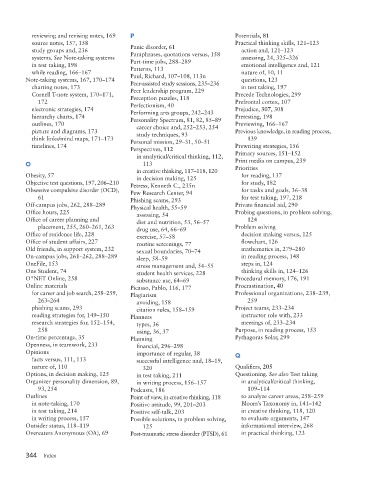Page 381 - Keys to College Success
P. 381
reviewing and revising notes, 169 P Potentials, 81
source notes, 157, 158 Practical thinking skills, 121–123
study groups and, 236 Panic disorder, 61 action and, 121–123
systems. See Note-taking systems Paraphrases, quotations versus, 158 assessing, 24, 325–326
in test taking, 198 Part-time jobs, 288–289 emotional intelligence and, 121
while reading, 166–167 Patterns, 113 nature of, 10, 11
Note-taking systems, 167, 170–174 Paul, Richard, 107–108, 113n questions, 123
Peer-assisted study sessions, 235–236
charting notes, 173 Peer leadership program, 229 in test taking, 197
Cornell T-note system, 170–171, Perception puzzles, 118 Precede Technologies, 299
172 Prefrontal cortex, 107
electronic strategies, 174 Perfectionism, 40 Prejudice, 307, 308
Performing arts groups, 242–243
hierarchy charts, 174 Personality Spectrum, 81, 82, 85–89 Pretesting, 198
outlines, 170 career choice and, 252–253, 254 Previewing, 166–167
picture and diagrams, 173 study techniques, 93 Previous knowledge, in reading process,
think links/mind maps, 171–173 Personal mission, 29–31, 50–51 139
timelines, 174 Prewriting strategies, 156
Perspectives, 112
in analytical/critical thinking, 112, Primary sources, 151–152
O 113 Print media on campus, 239
in creative thinking, 117–118, 120 Priorities
Obesity, 57 in decision making, 125 for reading, 137
Objective test questions, 197, 206–210 Petress, Kenneth C., 235n for study, 182
Obsessive-compulsive disorder (OCD), Pew Research Center, 94 for tasks and goals, 36–38
61 Phishing scams, 293 for test taking, 197, 218
Off-campus jobs, 262, 288–289 Physical health, 55–59 Private f nancial aid, 290
Off ce hours, 225 assessing, 54 Probing questions, in problem solving,
Off ce of career planning and diet and nutrition, 53, 56–57 124
placement, 255, 260–261, 263 drug use, 64, 66–69 Problem solving
Off ce of residence life, 228 exercise, 57–58 decision making versus, 125
Off ce of student affairs, 227 routine screenings, 77 f owchart, 126
Old friends, in support system, 232 sexual boundaries, 70–74 mathematics in, 279–280
On-campus jobs, 261–262, 288–289 sleep, 58–59 in reading process, 148
OneFile, 153 stress management and, 54–55 steps in, 124
One Student, 74 student health services, 228 thinking skills in, 124–126
O*NET Online, 258 substance use, 64–69 Procedural memory, 176, 191
Online materials Picasso, Pablo, 116, 177 Procrastination, 40
for career and job search, 258–259, Plagiarism Professional organizations, 238–239,
263–264 avoiding, 158 259
phishing scams, 293 citation rules, 158–159 Project teams, 233–234
reading strategies for, 149–150 Planners instructor role with, 233
research strategies for, 152–154, types, 36 meetings of, 233–234
258 using, 36, 37 Purpose, in reading process, 153
On-time percentage, 35 Planning Pythagoras Solar, 299
Openness, in teamwork, 233 f nancial, 296–298
Opinions importance of regular, 38 Q
facts versus, 111, 113 successful intelligence and, 18–19,
nature of, 110 320 Qualif ers, 205
Options, in decision making, 125 in test taking, 211 Questioning. See also Test taking
Organizer personality dimension, 89, in writing process, 156–157 in analytical/critical thinking,
93, 254 Podcasts, 186 109–114
Outlines Point of view, in creative thinking, 118 to analyze career areas, 258–259
in note-taking, 170 Positive attitude, 99, 201–203 Bloom’s Taxonomy in, 141–142
in test taking, 214 Positive self-talk, 203 in creative thinking, 118, 120
in writing process, 157 Possible solutions, in problem solving, to evaluate arguments, 147
Outsider status, 118–119 125 informational interview, 268
Overeaters Anonymous (OA), 69 Post-traumatic stress disorder (PTSD), 61 in practical thinking, 123
344 Index

